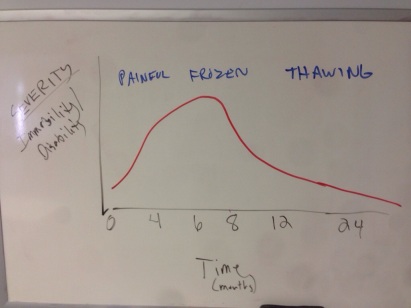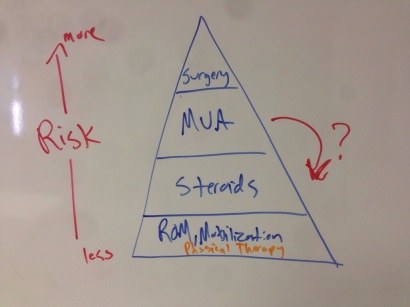https://intouchpt.wordpress.com/2014/05/08/when-do-you-recommend-mua-for-frozen-shoulder/?utm_source=The+Rotater%27s+%22Top+10%22+Newsletter&utm_campaign=e4fde9fae2-The_Rotater_TOP_10_6_25_156_25_2015&utm_medium=email&utm_term=0_b069c819d0-e4fde9fae2-327172017
Ahh, the mystical frozen shoulder. We have all had our share of patients, with frustration typically steaming out of both parties’ ears. It is a diagnosis usually made of exclusion, but a proper examination can help rule-in the condition. The onset is usually spontaneous, the cause of the condition is still unknown and not one conservative intervention has been exclusively shown to be superior.
As physical therapists, we strive for all patients to be treated conservatively. I do this for every condition and I will say 90%+ of patients should NOT need any other type of medical intervention, including medication & especially surgery. One that continues to stump me though is the challenging treatment of adhesive capsulosis (frozen shoulder). One of the main reasons is that if the shoulder is truly ‘frozen’, the average length of symptoms could last up ~30 months (average 1 year to 3 years). Three stages have been described in the literature, and typically are presented by the following graph:
I like treating orthopaedic cases that have a significant within-visit response and can get instantaneous gratification, even though full resolution will take some time. Besides a few interventions in lower realm of evidence (thoracic manipulation case report and dry needling case report), most of the time the treatment is slow.
This treatment process can be labeled a “difficult condition and even difficult patients”. With the deadlock of a condition as frozen shoulder can be, clinicians and patients could consider pulling the trigger SOONER than later to proceed with more risky interventions. One of the most common interventions is manipulation under anesthesia (MUA). With that said, the question remains: should MUA be considered earlier in the care for frozen shoulder patients? This could be a possible proposal to improve ROM, decrease pain and decrease disability in a more speedier fashion, THEN proceed with physical therapy care.
Let’s delve into this question further.
Anytime a procedure is performed, a risk:benefit analysis must be weighed. For the most part, any physical therapy procedure is extremely safe with very little adverse events. A low risk and over 90% success rate, the first choice for treating frozen shoulder should be physical therapy. However, the success can depend on what you perceive as a short period of time. Meaning, do you want to push through ~4 months of rehabilitation or will a MUA get you results sooner and get out of the frozen stage quicker?
For the sake of this post, I’ll skip steroid injections (as this is usually combined with ~12 weeks of therapy) and proceed to manipulation under anesthesia.
The procedure of MUA itself definitely has more risk, especially of possible fracture, rotator cuff tears, and labral tears. Also, some surgeons will avoid the procedure if the patient is a diabetic (insulin-dependent), which is a risk factor for the condition. This does not include the risks associated with anesthesia, which can be very high, including recently noted to double dementia risk. The benefit must then be weighed. I have always heard ~70% success rate with MUA. Let’s look at some more evidence:
In a study of 125 patients by Kivimaki, et al 2007 comparing MUA to HEP had this conclusion,
On the other hand, Dodenhoff et al 2000 expressed,
Vastamaki & Vastamki 2013 found in a low level study but followed patients a mean of 23 yrs showed,
Farrell et al 2005 looked at long-term (15 yrs) with the following results (however, it was after failure of conservative care),
Wang 2007 had this conclusion,
I would imagine physical therapy would be the most cost-effective intervention, but recent systematic review and cost-effectiveness analysis could not provide a conclusive outcome (no surprise since this is a systematic review!).
So in conclusion, the evidence doesn’t really provide us guidelines of using MUA besides suggesting it after failure of conservative measures. I could not find any studies that solely looked at performing MUA EARLIER (to then decrease the length of disability). Would the disability be less and recovery speedier?
My opinion:
I don’t have a true answer here and it all depends (don’t you hate that answer!?). I will say that I have seen many patients who respond solely to physical therapy services and not need anything more invasive, costly or risky as a MUA. However, there are ~5% of patients who just do not respond to PT. These have gone on to have MUA (or lysis) and have come back to PT with a significant improvement in ROM and then get to ~90% of prior function within a month. I am trying clinically to find out if they will respond to my care or will have to have another treatment earlier in the course of care. Pretty much all of my patients do not want to have another procedure and will rather continue with PT services, even if the course of treatment is slow. That makes a big difference too in regards to how to approach various treatment options.
What are your clinical judgments in regards to this? If you had a patient right now with frozen shoulder who has not shown improvement in ROM in the last ~4 weeks, but pain is still mild to moderate (NRPS: 2-4/10), would you continue with physical therapy or recommend MUA? Or, would you suggest continued care with hopes of transitioning to the ‘thawing’ stage quicker with further PT services?
At what time-frame do you consider conservative therapy to be a failure? Do you think physical therapists over-treat this condition and should recommend other measures sooner than later?


Cenforce 200mg Tablet is a pill that contains sildenafil citrate with a strength of 200 mg. It is the most noteworthy measurement type of sildenafil Citrate and hence, should just be utilized in outrageous instances of erectile dysfunction.
ОтветитьУдалить